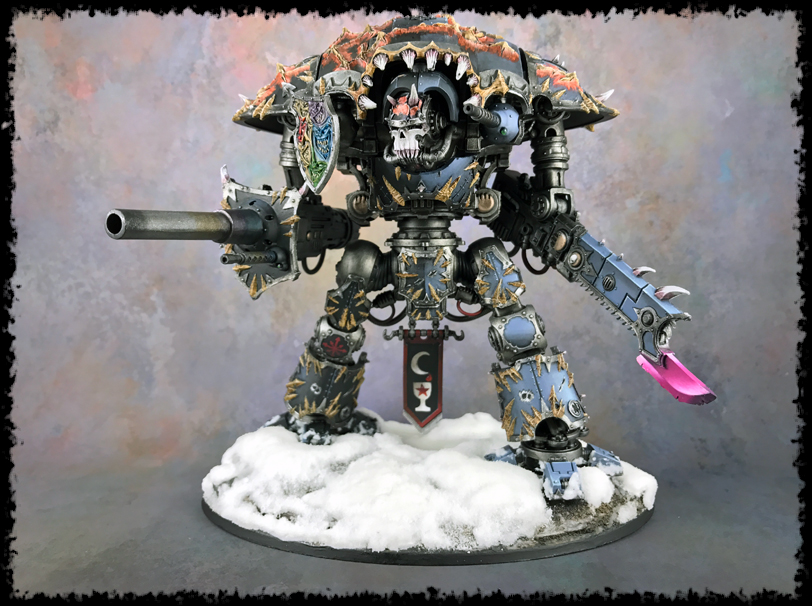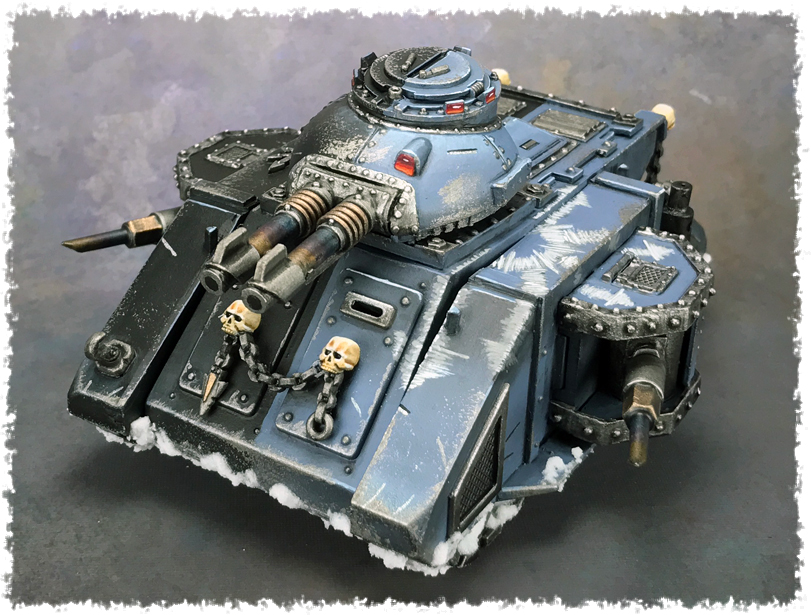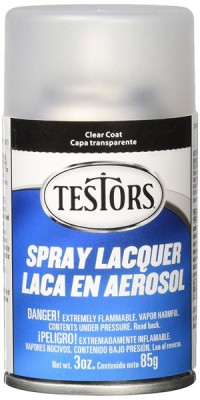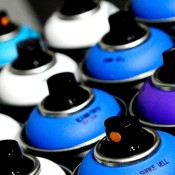Let me start by saying you don’t have to seal (varnish) your miniatures. That’s a choice you can totally make. However, I would recommend that you always seal your painted miniatures and here’s why.
Also, I use the term seal when talking about spraying a protection layer on your miniatures, however, the term varnish is widely used as well. The terms are completely interchangeable and it’s just a matter of your locality on which you use.
What I’m covering is why you should seal your models, how to seal your models, and I’ve also got some recommended brands of sealer that work great.
Sealing (Varnishing) Your Miniatures
Sealing your miniatures is the last step in a process. The first step is priming your models; make sure you do that – seriously.
After you’ve primed your models you then paint them.
Now, some of us can spend hours and hours on a single figure. I’m a slow painter because I tend to be meticulous, plus I’m always trying some new technique and get slowed down in learning.
I’ve had some models, like my Chaos Knight, that have taken me well over 20 hours to complete. When you put that much time into something you want to protect it. If I got a scratch on that Knight because I didn’t seal it then I would probably cry.
Not sealing your models is one of the most common mistakes that new painters make. Don’t make it!
What Does a Sealer (Varnish) Do?
So, a sealer is kind of like a layer of paint but a much sturdier layer of paint. A sealer creates a protective layer over the paint below it and bonds to it. Think of it like armor.
When you handle a miniature that has been sealed you are touching only the sealer. This means you won’t rub the paint off with use, which is probably the biggest reason to seal your models.
When you don’t seal your models, and you handle them routinely for games, then the paint will slowly wear thin and rub off over time. I don’t care how careful you are with your figures, the paint will wear off with handling, it’s only a matter of when.
Also, with a sealer being the outer layer on a miniature, it also means if it falls then it’s the sealer coat that takes the impact, not the paint. So, you instead will chip the sealer, or scratch the sealer instead of damaging the paint.
Now, I won’t claim that a sealer will completely protect your miniatures from damage. You can still hurt your paint job, however, it will minimize it and the difference between a damaged paint job that had sealer compared to one without is night and day.
Another thing sealer will do is help prevent your paint from fading due to light. We’ve all seen faded paint on houses and cars, and it can occur as well with a miniature. Sealing the miniature won’t stop that entirely but it will help a lot.
Any Downsides to Sealing (Varnishing)?
Most paints you use for painting your models are very dull. They don’t really reflect light and things look the way you intended. Sealers can increase the shine on your models and have them reflect more light than if they weren’t sealed.
That is a reason that some showcase miniature painters won’t seal their models, and the only time I agree with the choice. People who paint competitively, or for showcasing, want their models to have no reflectiveness, and no matter how dull a sealer is, there will also be some shine to it.
Note: The shine of a sealer can actually enrich the colors, so you’ll see some painters choosing sealers with a slight shine for that reason. It’s not entirely a downside, only when not intended.
There are occasions when a spray sealer won’t go on right and creates a cloudy finish. I’ve had this happen once to me and it about destroyed me.
The reason for the cloudy finish, in most instances, is either that the can was not shaken enough, there’s an issue with the sealer itself, or the conditions weren’t right (see below).
A tip, if this happens to you (cloudy finish), do another layer of sealer over the cloudy one the next day. Give that first cloudy layer a good 24 hours to dry and seal over it, ideally with a more reliable sealer. The second layer of sealer will penetrate the first and reduce the cloudiness of it.
Disclosure: Some of the links below are affiliate links, meaning, at no additional cost to you, I will earn a commission if you click through and make a purchase. The commission earned helps maintain this site.
Best Matte Varnish for Miniatures
Something you’ll see a lot of painters talk about is finding the most dull of the matte sealers around. The reason being we want to limit the light reflections and have our figures look the way we painted them.
There’s a few spray sealers I’ve used over the years, and the one I recommend the most is Testors Dullcote. The Knight image above, and the Predator tank below, were sealed with Testors Dullcote.
You’ll notice a distinct lack of shine on those models; that’s the Testors Dullcote. That stuff is amazing. It’s also great if you have a model that’s shiny and you want to reduce the shine.
Finding Testors can be a bit tricky sometimes. Most chain art stores in the U.S. carry it, like AC Moore, Michaels, and JOANN Fabrics.
Often you can also find it at hobby stores that carry model cars and trains. It’s a popular choice in the modeling hobby. Of course you can also snag it online too.
I have also used a matte sealer by Krylon with good success. It’s not as dull as Testors but it’s still dull.
The advantage of Krylon is it’s more readily available for most people and it’s cheaper. Other than online, you can usually find this at Walmart or any hardware store.
With both of those spray sealers I have never had an issue with a cloudy finish, so I can personally recommend them both to you.
Now, I’ve known some people to use Plaid sealer with good success. Kamui, another author here, has used it quite a bit and likes it.
Spray Conditions & Use
When you’re using a spray sealer, you want to do it in temperatures between 65 – 85 degrees Fahrenheit, or 18 – 29 Celsius. Also, you don’t want any humidity at all, or very minimal if no humidity isn’t possible.
Failure to meet those conditions can result in a cloudy finish, amongst other issues.
If you’re unable to spray seal in those proper conditions then you may want to consider a brush-on sealer, or an airbrush sealer.
How to Seal/Varnish a Miniature
Time needed: 1 minute
A few tips to help you get a nice coat of sealer on your miniatures.
- Spray from 10″ Away
You want to hold the spray can around 10″ from the miniature when you’re spraying it. If you get too close then you’ll build up the sealer too thick. Too far away and you’ll get a frosted look because the spray is drying before it reaches the model.
So, I find 10″ to be a good range to spray from. - Sweep Back and Forth
Start your spraying off the miniature then drag it to the miniature, over it, past it, and then stop. Starting the spray off the model will help avoid buildup. Stopping the spray off the model is for the same reason.
- Inspect That Everything Was Covered
This may also sound counter-intuitive, but make sure you get a good solid coat of sealer on the model. If you spray too lightly, and do too thin of a coat, then it will wear off easily. I always do two coats of sealer and I make sure each is a good solid coat and not too thin or spotty.
Brush-on Sealers
I do have a brush-on matte sealer on hand in case I need it. Most of the time I only use the brush-on sealer if I have to repair something later and I only want to seal that spot, not the entire model.
A brush-on sealer I’ve used is by Delta Creative and I got it at Joann’s, a chain craft store in the US.
It’s not as dull as either spray sealer mentioned above, but it’s not bad either. I wouldn’t use it on an entire model, but for spot sealing it works well. It’s also easy to find.

Another good brush-on matte sealer is by Vallejo. I’ve been using this lately (as needed) and it’s worked really well; better than the Delta Creative mentioned above.
I do also have a gloss brush-on sealer that I use when I want something to have a shine to it, like a gem, water, etc. The one I use for that is by Plaid, and I also got that at Joann’s.
So, it’s safe to say that you can safely get brush-on sealers at craft stores and they work well.
Airbrush Sealers
I haven’t gotten into airbrushing yet, so if anyone has recommendations for airbrush sealers then please let me know in the comments. You’ll be given credit.
My Top Picks for Sealers
Here’s a quick reference sheet for my tip picks for matte sealers.
I’m only listing matte sealers since few of us are after anything else.
CHOOSE
Your Plan
Disk Space
Databases
Domains
Users
Email Accounts
Vallejo
brush-on
CHeap
Brush-on
Dries dull
Good quality
hard to find
Krylon
spray
cheap
spray
dries dull
good quality
Easy to find
Testors
spray
Expensive
spray
dries dullest
great quality
easy to find
Conclusion
You put hours into painting something you love, so why wouldn’t you protect it with a sealer?
Sure, you’ll hear some horror stories with sealers, but don’t let that put you off. Find a good sealer, like the ones suggested above, and make sure you seal in proper conditions. If you do that then you should never have an issue.
I’ve only had an issue once since I started painting in 2006. It was because the sealer I was using was very temperamental to humidity, and it was a bit humid that day.
It sucked, I was pissed off, but I learned a lesson and haven’t had a problem since.
What’s your recommendation on sealers for models?
Hobby Supplies, Tips & Tutorials
Various tutorials and guides for common hobby supplies.
- Creative Twilight’s Future and My Thoughts (Feedback Welcomed!) - December 4, 2021
- My Top Gift Ideas for Miniature Painters & Hobbyists + Gifts to Avoid - December 2, 2021
- The Year That Was 2020 and Where I’ve Been - January 17, 2021







Yep, frosting sucks. I steer clear of GW Purity Seal, never had a problem with Army Painter Matt Spray or Army Painter Aegis Suit Satin Spray.
I have heard nothing but horror stories with Purity Seal. I haven’t tried the Army Painter line, but I can see it being a quality option. I’ll add that to the list above.
I also use Dullcote. The only issue I have is when trying to cover a gloss finish (used under transfers). It takes two or three tries to get all the shiny parts properly covered. That’s mostly because of things like shoulder pad rims blocking the spray.
I use a brush on gloss sealer before applying transfers, but I’ve always wondered what a full Marine would look like with gloss brushed over just his armor plates would look like.
It was seeing your Ultramarines that turned me onto Dullcote all those years ago.
I’ve seen some people use a satin or gloss finish on something as a shortcut and it works. Not a Marine, but other models. The caveat though is you need to paint it with regards to the finish. So, you wouldn’t do a ton of blending or anything fancy on the armor because it would get lost in the reflection. It’s surprisingly tricky to pull off well.
Always sandwich the waterlide (or other) transfer between 2 layers of gloss – then the Dullcote dries flat, and any edgeing effects of the clear bits around the edges of the transfer tend to disappear also
Valuable advice, thanks for sharing.
Do you all have Testors Dullcote across the pond?
Not looked into it myself, so no clue.
Testors dullcote is available in the UK since they created a EU-legal formula, though it’s often out of stock. I’m not a massive fan of spraycan matt varnishes because of the frosting risk – the UK is either too cold and soggy, or too humid for comfort!
I’ve switched to either army painter brush-on, or vallejo premium varnish through the airbrush depending upon how much I need to do. The premium range is intended for RC cars, but I’ve found it airbrushes much easier (less clogging) and gives a smoother finish than the standard polyurethane vallejo varnish. You do have to be a bit obsessive about cleaning the airbrush though, as with all varnish.
Ah yes, the lovely weather; forgot about that.
Humidity is the real killer for me when it comes to sealing minis. It rarely drops below about 40% humidity around here anymore, regardless of time of year. Very frustrating.
Do you have an airbrush?
Nope. Some of my disability issues make the necessary setup and cleanup time impractical. Too often, I can only get it together to paint for a bit, and I’ll have to stop suddenly when I start shaking too much or something. There would be too many times when cleanup didn’t happen on time, or at all.
Gotcha. I know we talked about sealing a bit in another article, but I couldn’t recall the airbrush part, well, if I asked. Hell, I don’t have any disabilities and I feel that airbrush cleanup is impractical ;)
Truth be told, I thought it seemed like too much work even before my health got this bad. But now it’s just completely out of the question.
It’s why I don’t own one ;)
I don’t actually find the airbrush cleanup to be that much of a hassle. I usually just rinse the pot then run some water through the brush until it sprays clear, then I run a little alcohol through it to clear up any resistant residue.
Anyway, the nice thing about sealing (or priming) with an airbrush is that you don’t have the propellant fumes you get from an aerosol can. So it’s a lot easier to do inside without poisoning yourself, making it much less weather dependent. I don’t remember what brand I was using for a sealer and I threw it away because it solidified in the bottle…
It just seems everyone I talk to has the hardest time getting their airbrush to run right (bent needles, clogged nozzle, etc), and keeping it clean. May just be the vocal minority though.
Sealing and priming are where I’d use one the most actually. Being able to do those things at my desk would be awesome.
Needles don’t bend themselves. They’re a little more robust than a typical sewing needle so if you’re careful with them you should be fine, and they’re relatively cheap so you can replace them when they do get bent. I haven’t managed to bend mine yet.
Dried/chunky paint can become a nightmare if you’re not careful. You want to make sure you thin the paint adequately, make sure there aren’t any clots in it, and make sure you keep it wet in the brush. Just like a bristle brush, you never want to let the paint dry in it! I dip the nozzle in some alcohol periodically while I’m painting to keep the paint from building up in it. Kind of like rinsing your bristles before each time you pick up paint from the palette. Every time I switch colors I purge the brush with alcohol. And I never let the paint sit in there long enough to start congealing. If you keep the brush clean while you’re using it you won’t have to pull out the needle very often, which means you are much less likely to bend it.
When I get my hobby area set up again maybe you can stop by and try out my airbrush some time.
Fair enough, and good explanation relating it back to brush work.
At the end of the day, I’m human and lazy. So, from the outside I see an airbrush as extra work, but the reality may be very different, as you’re suggesting. I’d gladly give it a go at some point though. Hell, I still have the one you lent me. Haven’t used it ;)
It takes a bit of practise to get used to the constant cleaning routine of an airbrush, but you can get it down to pretty quick – my end of session airbrush clean only takes me 5 minutes now (flush with acetone then water, a quick clean of the nozzle cap with a qtip and a quick needle wipe & lube). About the same as a hairy brush post-session with brush soap, though admittedly I don’t have to do that every time!. If it’s playing up, it gets a session in the sonic cleaner – which also works nicely on paintbrushes!
Don’t let paint dry in it, just as you wouldn’t on a hairy brush – easier to use a small amount of paint in the cup, quick flush through with water, then some more, than put a load in the cup and have it dry and clog up. A bit of flow aid (one or two drops per cup) helps a lot with most acrylics, and drying retarder for the most annoying ones. An old toothbrush is great for cleaning off tip dry, or a q-tip.
Even just doing primer coats is nice and quick with a lovely finish, and you don’t usually have to touch up with a brush afterwards so it saves time overall.
Thanks for the advice. I’ll get an airbrush some day I’m sure and then I’ll wonder how I lived without one no doubt ;)
I can recommend AK interactive Ultra Matte varnish. Really good finish, can be applied with brush or airbrush. Never had white dots or blurry effect.
A word of caution when using airbrush for varnishing (which I routinely do). It is common practice to add a few drops of thinner or flow improver in you airbrush mix to avoid tip clogs on the airbrush needle. This is true for paint and varnish as well. But be careful of not thinning your varnish too much otherwise, the pumice like particles in the varnish might pool on your minis recesses and create the dreaded white speckles.
Awesome. Thanks for the recommendation and I appreciate the tip!
Adorei conhecer seu blog, tem muito artigos bem interessantes. webwhats.com.br